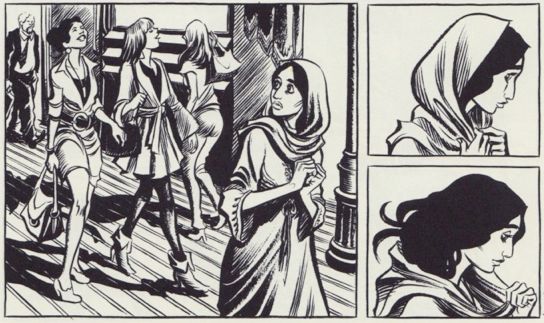I'm not even paraphrasing! In a lengthy and fascinating interview with Nadim Damluji, the writer whose thoughtful critique of Craig Thompson's Habibi spearheaded the discussion of Thompson's use of Orientalist tropes and stereotypes in his depiction of Arab and Islamic culture and people (particularly women), Thompson comes right out and welcomes all the sticky, tricky, at times uncomfortable and unpleasant associations his use of harems, slavers, sultans and so on call to mind.
I knew [Habibi's main characters, Dodola and Zam] were child slaves from the start, but I didn’t know what kind of world they inhabited. And my research of slavery and randomly reading books about slavery pointed me in the direction of the East African/Arab slave trade that predated the cross-Atlantic slave trade by 700 years. As I was reading some of those research books they eluded often to 1,001 Arabian Nights which drew me towards that, and while reading Nights I became aware of the Orientalism in the Richard Burton anthology. Around the same time I started studying Islamic Art. But I did attach myself fairly early on to the Arabian Nights landscape. Right away I could see it for both its strength and weaknesses, but I thought of it as a genre that would be fun to work in like Superheroes, Science Fiction, or Noir.
ND: But is just such a loaded genre…
CT: Yeah! Bring it on, right!
ND: And I think that’s ultimately my response: it’s hard separating you as a creator who’s clearly very sympathetic and is so good at humanizing characters — which comes across so well in the Qur’anic parts — and the fact that you are swinging around in this playground that is so deeply tied up in a history of otherizing.
CT: And ultimately I like the conflict between those two elements.
Say what you will about the wisdom or success of this tactic, but I think it puts paid to the notion that Thompson went about this project heedless of his work's complications, or the potential negative reception. But then I've long thought that about Thompson -- Blankets seems to quite obviously contain a critique of his teenage self's swoony idealization of the romantic relationship at its center.
Anyway, it's not every day that you get to read a really good critic directly challenge a really good cartoonist on his work's most problematic aspects, especially when they involve the touch the parallel third rails of religion, race, and sex all at once. And it's even rarer that the conversation goes as smoothly and non-defensively/accusitorially as this one. (Even the (perhaps unjustifiably) infamous "Dodola removes her headscarf" sequence is brought up, and resolved to what seems to be the mutual satisfaction of both parties.) See for yourself.

